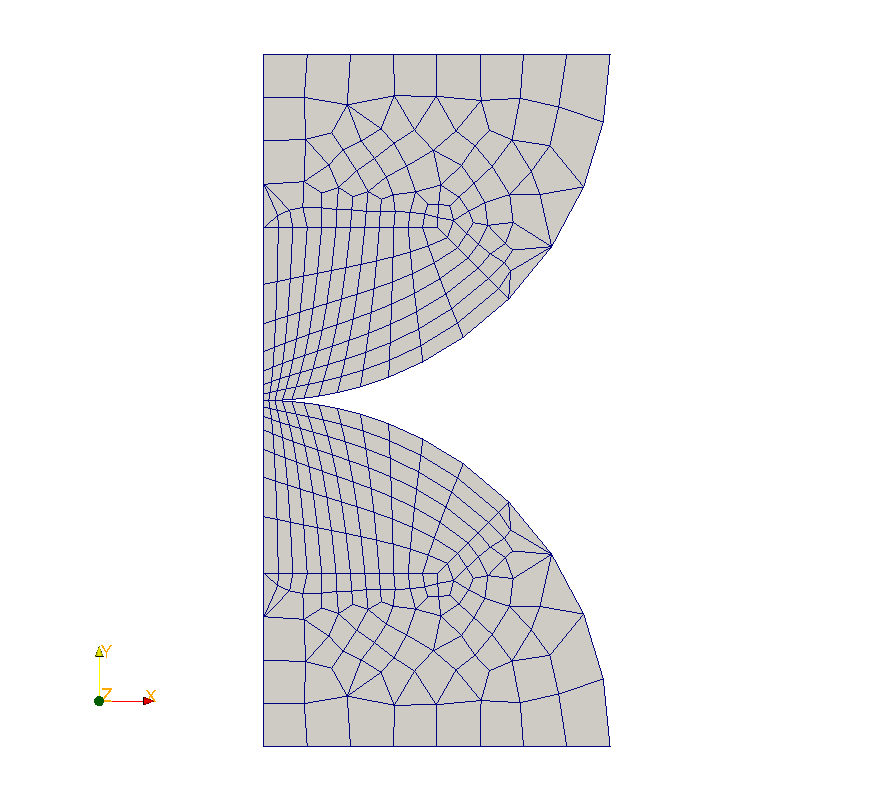7.3. Tested sizes and results
First calculation (nodal pairing, master-slave normal and algorithm “PENALISATION”)
Identification |
Reference type |
Reference value |
Tolerance |

mesh \(\mathit{M31}\) knot \(\mathit{N291}(G)\)
|
“ANALYTIQUE” |
-2798.3 \(N\) |
7.0% |
|
|
|
\(\mathrm{DX}\) knot \(\mathit{N291}(G)\) |
“ANALYTIQUE” |
0 \(\mathit{mm}\) |
1.0E-10 |
\(\mathrm{DX}\) knot \(\mathit{N287}(H)\) |
“NON_REGRESSION” |
-0,110211 \(\mathit{mm}\) |
|
\(\mathrm{DY}\) knot \(\mathit{N287}(H)\) |
“NON_REGRESSION” |
-0,162912 \(\mathit{mm}\) |
|
\(\mathrm{DX}\) knot \(\mathit{N285}(I)\) |
“NON_REGRESSION” |
-0,165946 \(\mathit{mm}\) |
|
\(\mathrm{DY}\) knot \(\mathit{N285}(I)\) |
“NON_REGRESSION” |
-0.629667 \(\mathit{mm}\) |
|
Second calculation (normal master-slave, algorithm “PENALISATION”)
Identification |
Reference type |
Reference value |
Tolerance |

mesh \(\mathit{M31}\) knot \(\mathit{N291}(G)\)
|
“ANALYTIQUE” |
-2798.3 \(N\) |
7.0% |
|
|
|
\(\mathrm{DX}\) knot \(\mathit{N291}(G)\) |
“ANALYTIQUE” |
0 \(\mathit{mm}\) |
1.0E-10 |
\(\mathrm{DX}\) knot \(\mathit{N287}(H)\) |
“NON_REGRESSION” |
-0,110678 \(\mathit{mm}\) |
|
\(\mathrm{DY}\) knot \(\mathit{N287}(H)\) |
“NON_REGRESSION” |
-0,162865 \(\mathit{mm}\) |
|
\(\mathrm{DX}\) knot \(\mathit{N285}(I)\) |
“NON_REGRESSION” |
-0,167194 \(\mathit{mm}\) |
|
\(\mathrm{DY}\) knot \(\mathit{N285}(I)\) |
“NON_REGRESSION” |
-0.628961 \(\mathit{mm}\) |
|
Third calculation (normal master-slave, algorithm “CONTRAINTE”)
Identification |
Reference type |
Reference value |
Tolerance |

mesh \(\mathit{M31}\) knot \(\mathit{N291}(G)\)
|
“ANALYTIQUE” |
-2798.3 \(N\) |
7.0% |
|
|
|
\(\mathrm{DX}\) knot \(\mathit{N291}(G)\) |
“ANALYTIQUE” |
0 \(\mathit{mm}\) |
1.0E-10 |
\(\mathrm{DX}\) knot \(\mathit{N287}(H)\) |
“NON_REGRESSION” |
-0,110678 \(\mathit{mm}\) |
|
\(\mathrm{DY}\) knot \(\mathit{N287}(H)\) |
“NON_REGRESSION” |
-0,162901 \(\mathit{mm}\) |
|
\(\mathrm{DX}\) knot \(\mathit{N285}(I)\) |
“NON_REGRESSION” |
-0,167194 \(\mathit{mm}\) |
|
\(\mathrm{DY}\) knot \(\mathit{N285}(I)\) |
“NON_REGRESSION” |
-0.628947 \(\mathit{mm}\) |
|
Fourth calculation (smoothing, master-slave normal and algorithm “CONTRAINTE”)
Identification |
Reference type |
Reference value |
Tolerance |

mesh \(\mathit{M31}\) knot \(\mathit{N291}(G)\)
|
“ANALYTIQUE” |
-2798.3 \(N\) |
7.0% |
|
|
|
\(\mathrm{DX}\) knot \(\mathit{N291}(G)\) |
“ANALYTIQUE” |
0 \(\mathit{mm}\) |
1.0E-10 |
\(\mathrm{DX}\) knot \(\mathit{N287}(H)\) |
“NON_REGRESSION” |
-0,110211 \(\mathit{mm}\) |
|
\(\mathrm{DY}\) knot \(\mathit{N287}(H)\) |
“NON_REGRESSION” |
-0,162911 \(\mathit{mm}\) |
|
\(\mathrm{DX}\) knot \(\mathit{N285}(I)\) |
“NON_REGRESSION” |
-0,165946 \(\mathit{mm}\) |
|
\(\mathrm{DY}\) knot \(\mathit{N285}(I)\) |
“NON_REGRESSION” |
-0.629666 \(\mathit{mm}\) |
|
